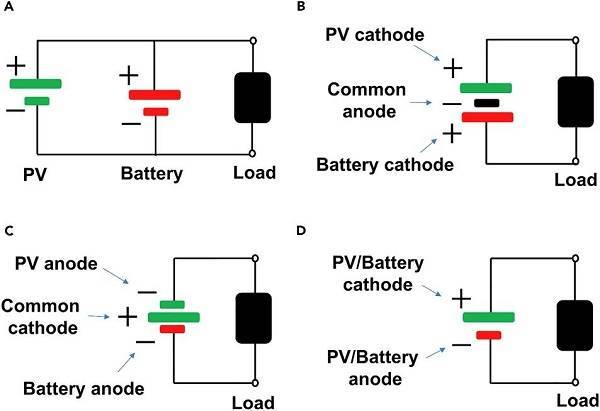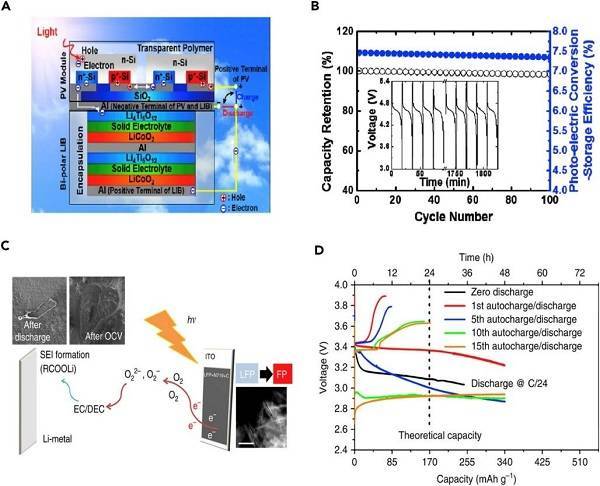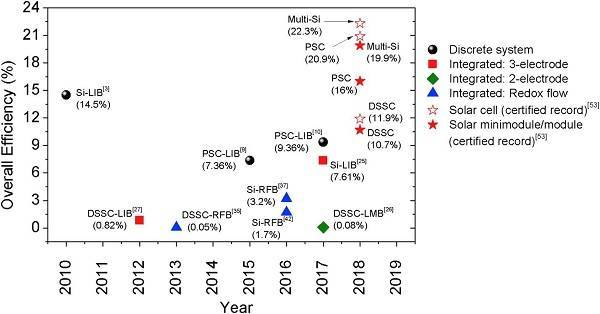
Solar Rechargeable Battery: Advantages, Challenges and Opportunities
【Brief description】 The energy issue is an eternal topic in today's world. It has led to the development of electronic devices, new energy vehicles, and smart grids. Solar energy as a clean and sustainable energy source
The energy issue is an eternal topic in today's world. It has led to the development of electronic devices, new energy vehicles, and smart grids. Solar energy as a clean and sustainable energy source can make up for the deficiency of the battery, and the battery can make up for the intermittent problem of solar energy. How to organically integrate solar cells and energy storage batterys? Recently, Prof. Qiquan Qiao (Corresponding author) from South Dakota State University in the United States has summarized, discussed, and looked forward to the problems encountered in the design of an integrated system for “solar cell-energy storage battery”. Among them, the three important parameters in the " solar cell-energy storage battery " integrated system: energy density, efficiency, and stability are each interpreted one by one.
1. The need for integrated solar cell-energy storage battery
Today's mass consumers rely heavily on energy technologies and their development. The current three key energy-related technologies are smart electronics, electric vehicles and smart grids. Intelligent electronic products rely on batteries with limited capacity and require the use of wired connections to frequently charge electronic devices. Solar energy or photovoltaic provide the possibility of charging the battery because in the outdoor sunlight, the energy density of the solar energy can reach 100 mW /c㎡ . At present, another prosperous market is the electric vehicle industry. Although electric vehicles do not produce carbon emissions, most of the electricity used by the vehicles comes from the fossil fuel-driven power grid. Unless vehicles use electricity from renewable sources, the sustainability of electric vehicles is of little significance. In addition, the distribution of charging stations also limits their practical application. Distributed generation such as photovoltaic power generation is the most suitable charging method for electric vehicles. Another foreground application is the power grid. The application of renewable energy is steadily expanding. The biggest problem with using photovoltaic energy is the lack of sunlight at night or on cloudy days, resulting in intermittent power supply during use. This intermittency can result in power fluctuation output, which is a key issue for grid applications. Therefore, power companies limit the power of photovoltaic power into the grid. As a result, the potential of photovoltaic power generation is not fully utilized. The energy storage battery can solve these problems. The battery can be charged during the day and discharged at night, which provides the possibility of photovoltaic power generation access to the power grid.
2. Comparison of traditional and advanced " solar cell-energy storage battery " systems
The traditional method of using a solar cell to charge a battery is that the two systems are designed independently (FIG. 1A), which involves the solar cell and the energy storage battery connected as two separate units by wires. Such systems are often expensive, cumbersome, and inflexible. They also require a relatively large space. In addition, external wires can cause power loss.
Combining production capacity and energy storage into one unit to achieve an integrated design will effectively solve the energy density problem of solar cells and batteries. This design has the characteristics of miniaturization, which in turn reduces the cost and increases the practicality of the photovoltaic system. Although there are many advantages, there are still great challenges in terms of efficiency, capacity, and stability. At present, research in this area is still in its infancy. The focus of research is mainly on the design of materials and devices.
Integrated photovoltaic cell systems can be implemented in two different configurations: three electrodes (Figures 1B and 1C) and two electrodes (Figure 1D). In the three-electrode design, one electrode is used as a common electrode as a cathode or anode between the photovoltaic device and the battery. In the two-electrode configuration, the positive and negative electrodes perform the light conversion function and the energy storage function simultaneously.

Figure 1 Independent design of traditional solar cell and energy storage battery (A), three-electrode design (B and C) and two-electrode design (D)
3. Design of binary separation type "solar cell-energy storage battery"
This section summarizes the work of predecessor separation “solar cell-energy storage battery” design. Silicon solar cells, perovskite solar cells, and dye-sensitized solar cells can be combined with lithium ion batteries in different forms. Among them, Figures 2A and B show that four series-connected perovskite solar cells are used to charge lithium ion batteries with an efficiency of 7.36%. The Qiao Qiquan team of the paper used transformers and maximum power point tracking to realize the use of single-cell perovskite solar cells to charge lithium-ion batteries. The efficiency reached 9.36%. The results of the study were published on Advance Energy Materials (Figure 2C and D).

Figure 2 separated photovoltaic cell system
(Figure A, Figure B) Recharging Li4Ti5O12/LiFePO4 Lithium-Ion Batteries Using Four Perovskite Solar Cells
(Figure C, Figure D) Recharge Li4Ti5O12/LiCoO2 Lithium-ion Battery with Single-cell Perovskite Solar Cell under assistance of DC-DC Converter.
4. Monolithically integrated "solar cell-energy storage battery" design
Most of the design work on the monolithically integrated “solar cell—energy storage battery” focuses on the combination of solar cells and capacitive energy storage rather than batteries. The integrated system can be divided into three types of designs: (1) direct integration, (2) light-assisted integration, and (3) redox flow battery integration. Direct integration involves stacking solar cells and batteries together (excluding redox flow batteries). Light-assisted integration uses solar energy to charge the battery with only a portion of the energy. Redox flow integration involves the use of redox flow batteries with solar charging. The article gives a detailed summary of the work of these three forms of predecessors. Figures 3, 4 and 5 are their typical representatives.

图3 直接集成
硅太阳能电池充Li4Ti5O12 / LiCoO2 锂离子电池的三电极的(A)设计示意图和(B)光电充电/恒流放电循环性能。混合染料及磷酸铁锂为正极、锂金属为负极的双电极设计的(C)示意图及充电过程和 (D)充/放电电压曲线。

图4 光辅助充电集成
染料敏化的TiO2光电极与锂氧电池的氧电极集成的(A)示意图和(B)充电曲线。染料敏化太阳能电池与Li / LiFePO4锂离子电池集成(C)示意图和 (D)光辅助充电曲线。

图5 太阳能与液流电池的集成
基于Li2WO4 / LiI双相电解液的太阳能可充电氧化还原液流电池(A)示意图和(B)光电充电、恒电流放电电压曲线。双硅光电化学电池和醌/溴氧化还原液流电池的集成的(C)示意图,(D)恒流放电曲线和 (E)整体效率。
5.技术上的挑战和机遇
5.1 能量密度
传统的锂离子电池为了提高其能量密度常采用卷绕式的封装方式,而对于“太阳能电池-储能电池”集成系统是不可行的。 因为锂离子电池的封装方式影响了接受太阳能的面积。太阳能电池的数量及功率需要与储能部分相互匹配可以解决可用的PV表面积,可能的堆叠电池数量以及功率匹配需要。使用高比容量的材料做电极可以提高系统的整体能量密度,比如硅-NMC电池具有400 kW/kg 的能量密度,而且硅又是一种光伏材料,如果在集成系统里硅既可以做锂离子电极又可以做光伏电极,将是一个理想的设计。硅太阳能电池需要很高的结晶度,而嵌锂后会使硅的结晶度下降,这需要找到一个优化的平衡点。锂金属电池的研究也为提高系统的整体能量密度提供了可能。此外,据文献报道光转换材料钙钛矿已被证明具有嵌入锂离子的能力,而且在钙钛矿中掺杂锂离子对其光伏性能有积极影响,这使得钙钛矿也有可能成为集成光伏电池系统高容量的双功能材料。对于要求较高体积比能量的应用,将是比较合适的。

图6 近年来“太阳能电池-储能电池”集成系统的效率
理想化集成系统的整体效率是太阳能转化效率与储能系统的乘积,集成系统所能达到的最大效率受限于太阳能转化效率,在现实中设计中集成系统的效率还要考虑到各种损耗。硅太阳能电池和钙钛矿电池能提供更高效的光电转化,会在集成系统中提供更好的整体效率。如果要使太阳能电池提供更大的效率,另一个需要考虑的因素是最大功率追踪(MPPT),这使得太阳能电池可以提供最大的功率。储能电池方面,需要选择最匹配的正负极以使库伦效率最大化。
5.3 稳定性
稳定性需要考虑光稳定性、电化学稳定性以及环境稳定性,这需要谨慎的选择电极材料。虽然人们在钙钛矿太阳能电池稳定性研究方面取得了可喜的进展,但是仍处于初步研究阶段,如果选择钙钛矿作为集成系统的光伏部分,还需要在钙钛矿的研究上有更大的突破才行。液体电解液的使用也不利于系统的稳定性,可以选择使用固态电解质来提高整体系统的安全性和稳定性。因为太阳能电池部分会产生热量,所以在选择储能电池电极材料的同时也要考虑其耐高温性能。
6.未来发展方向及展望
集成“太阳能电池-储能电池”系统尚处于早期研究和开发阶段。迄今为止的文献报道都着重于创新材料开发的可行性和新的设备设计,未来的研究应朝这个方向继续发展。新颖的设计需要和高容量,高效率和更稳定的材料相结合。优化集成系统可以使用以下策略,如使用能量转化以及储存双功能材料,使用大容量储能材料,最大功率跟踪,集成锂离子电容器,使用固态电解质,提高电化学电极和电解质之间的兼容性等。集成系统可以利用仿真或建模的方法,以更好地预测系统表现,为集成系统提供更好的设计方案。除此之外,未来的努力应该向将“太阳能电池-储能电池”集成系统与诸如传感器网络,可穿戴设备和电子设备等实际应用相结合。虽然目前“太阳能电池-储能电池”集成系统的商业化还有很长的路要走,但其发展将大大受益于目前光伏和电池领域的飞速进展。其未来的发展方向也将从最初的针对低功耗、紧凑的应用,进而向大规模能源应用发展。
来源: 材料牛
Hot News
undefined
Related News